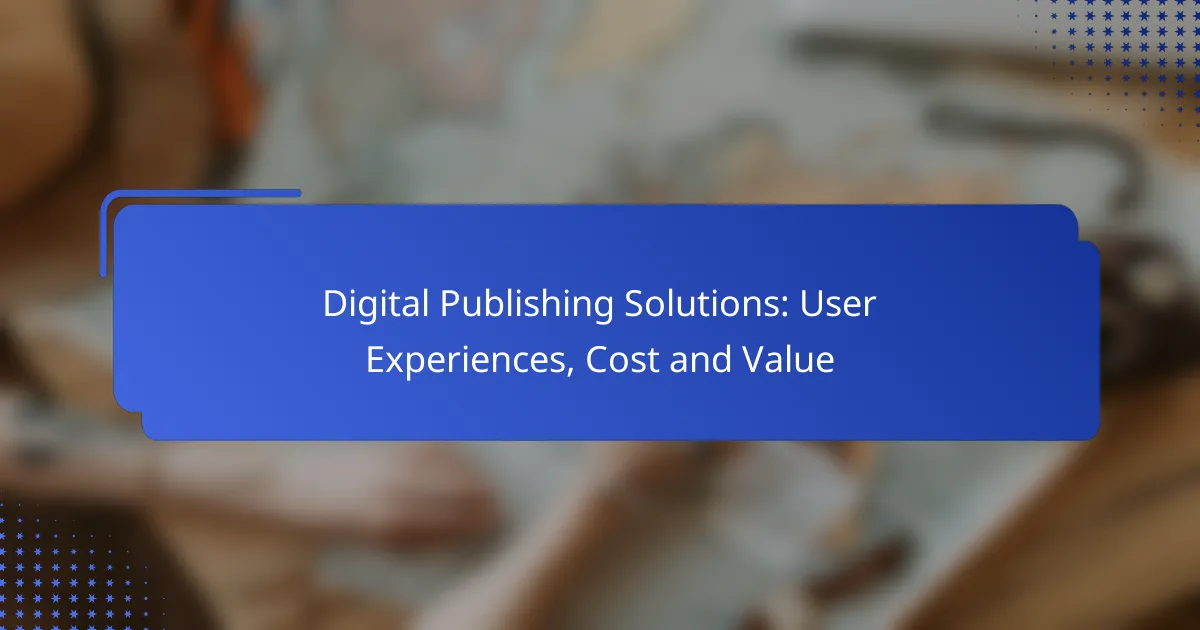Digital publishing solutions offer a range of tools designed to meet diverse user needs, from professional design capabilities to intuitive interfaces. With platforms like Adobe InDesign, Canva, and Flipsnack, users can find options that align with their specific requirements and budget. The overall experience can vary greatly depending on the platform’s user interface, customization, and collaboration features, all of which play a crucial role in content creation and distribution. Understanding the cost structures associated with these solutions is vital for ensuring a worthwhile investment.

What are the best digital publishing solutions in Ireland?
The best digital publishing solutions in Ireland cater to various needs, from professional design to user-friendly interfaces. Popular options include Adobe InDesign, Canva, Lucidpress, Pressbooks, and Flipsnack, each offering unique features and pricing structures suitable for different users.
Adobe InDesign
Adobe InDesign is a leading professional desktop publishing software widely used for creating print and digital media. It offers advanced layout and design capabilities, making it ideal for magazines, brochures, and eBooks.
Consider the subscription cost, which typically ranges from €20 to €30 per month, depending on the plan. While it has a steeper learning curve, its powerful tools justify the investment for serious designers.
Canva
Canva is an accessible online design platform that simplifies the creation of digital content. It features a drag-and-drop interface with numerous templates, making it suitable for users with varying design skills.
Canva offers a free version, while the Pro version costs around €12.99 per month. This affordability and ease of use make it a popular choice for small businesses and individuals looking to produce professional-looking materials quickly.
Lucidpress
Lucidpress is a web-based design tool that focuses on brand management and collaborative publishing. It allows teams to create and share marketing materials while maintaining brand consistency.
Pricing starts at approximately €10 per month for individual users, with options for teams. Its intuitive interface and collaborative features make it a strong choice for businesses aiming to streamline their design processes.
Pressbooks
Pressbooks is a specialized platform for creating and publishing eBooks and print books. It is particularly popular among authors and educators for its ease of use and integration with WordPress.
Pressbooks offers a free version with basic features, while premium plans start around €19 per month. This makes it an attractive option for self-publishing authors looking for a straightforward way to format their works.
Flipsnack
Flipsnack is a digital publishing tool that transforms PDFs into interactive online flipbooks. It is ideal for creating engaging presentations, catalogs, and magazines that can be easily shared online.
Pricing starts at about €14 per month for the basic plan. Flipsnack’s focus on interactivity and ease of sharing makes it a great choice for marketers and educators looking to enhance their digital content.
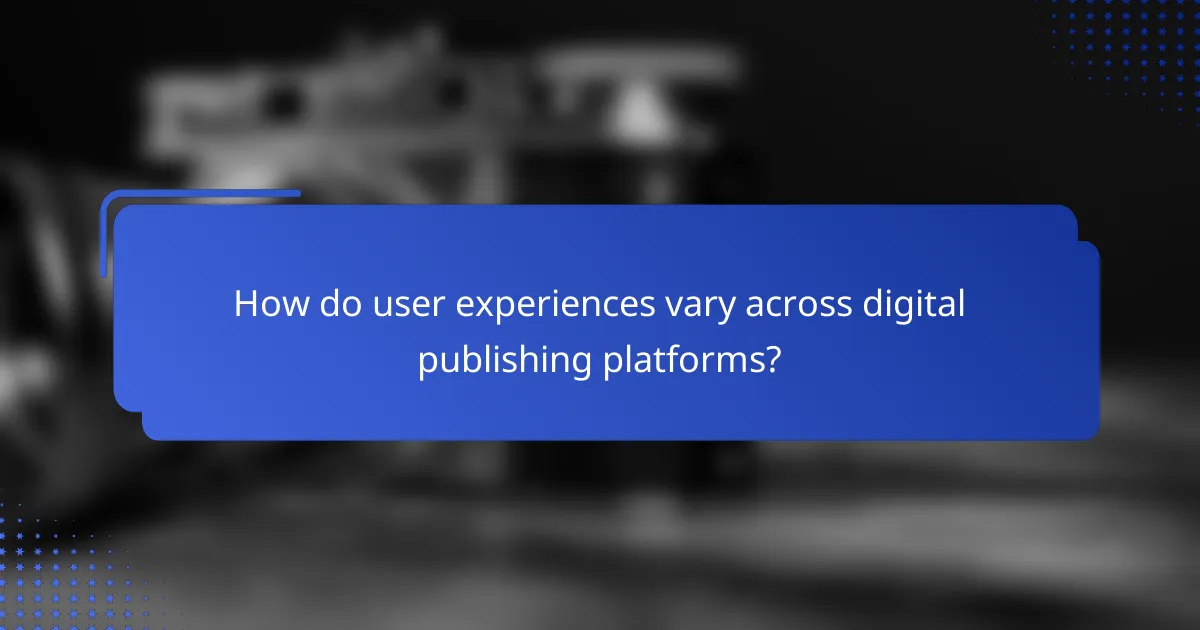
How do user experiences vary across digital publishing platforms?
User experiences across digital publishing platforms can differ significantly based on factors such as user interface design, customization options, and collaboration features. These elements impact how effectively users can create, manage, and distribute content, influencing overall satisfaction and productivity.
User interface design
User interface design plays a crucial role in how easily users can navigate a digital publishing platform. A clean, intuitive layout can enhance user experience, while a cluttered or confusing interface can lead to frustration. Look for platforms that prioritize user-friendly design, offering clear menus and easy access to essential tools.
Consider platforms that provide customizable dashboards, allowing users to arrange features according to their workflow. This flexibility can significantly improve efficiency, especially for teams with varying needs.
Customization options
Customization options enable users to tailor their digital publishing experience to better fit their specific requirements. Platforms that offer a range of templates, themes, and layout adjustments allow users to create unique content that aligns with their brand identity.
When evaluating customization features, check if the platform supports advanced options like custom CSS or HTML. This capability can be particularly valuable for organizations seeking to maintain a consistent look and feel across all published materials.
Collaboration features
Collaboration features are essential for teams working on digital publishing projects. Platforms that facilitate real-time editing, commenting, and version control can streamline the content creation process and enhance teamwork. Look for tools that allow multiple users to work simultaneously, reducing bottlenecks and improving productivity.
Additionally, consider platforms that integrate with popular communication tools, such as Slack or Microsoft Teams, to keep team members connected. Effective collaboration features can significantly impact project timelines and overall output quality.

What are the costs associated with digital publishing solutions?
The costs of digital publishing solutions can vary significantly based on the model chosen, the features required, and any additional services. Understanding these costs is essential for budgeting and maximizing the value of your investment.
Subscription pricing models
Subscription pricing models typically involve monthly or annual fees that grant access to digital publishing tools and platforms. These fees can range from low tens of USD for basic services to several hundred USD for comprehensive packages with advanced features.
When considering subscription options, evaluate the features included, such as storage capacity, user limits, and support services. Many providers offer tiered pricing, allowing you to choose a plan that best fits your needs and budget.
One-time purchase costs
One-time purchase costs involve a single payment for software or tools used in digital publishing. This model can be appealing for those who prefer not to commit to ongoing fees, with prices often ranging from a few hundred to several thousand USD depending on the complexity and capabilities of the software.
Keep in mind that while one-time purchases eliminate recurring costs, they may require additional investments for updates, support, or add-ons in the future. Assess the long-term value and potential hidden costs before making a decision.
Hidden fees and add-ons
Hidden fees and add-ons can significantly impact the overall cost of digital publishing solutions. Common examples include charges for additional storage, premium support, or advanced features that are not included in the base price.
To avoid surprises, carefully review the pricing structure and terms of service before committing. Ask potential providers about any extra costs and consider negotiating for a more inclusive package that meets your needs without unexpected expenses.
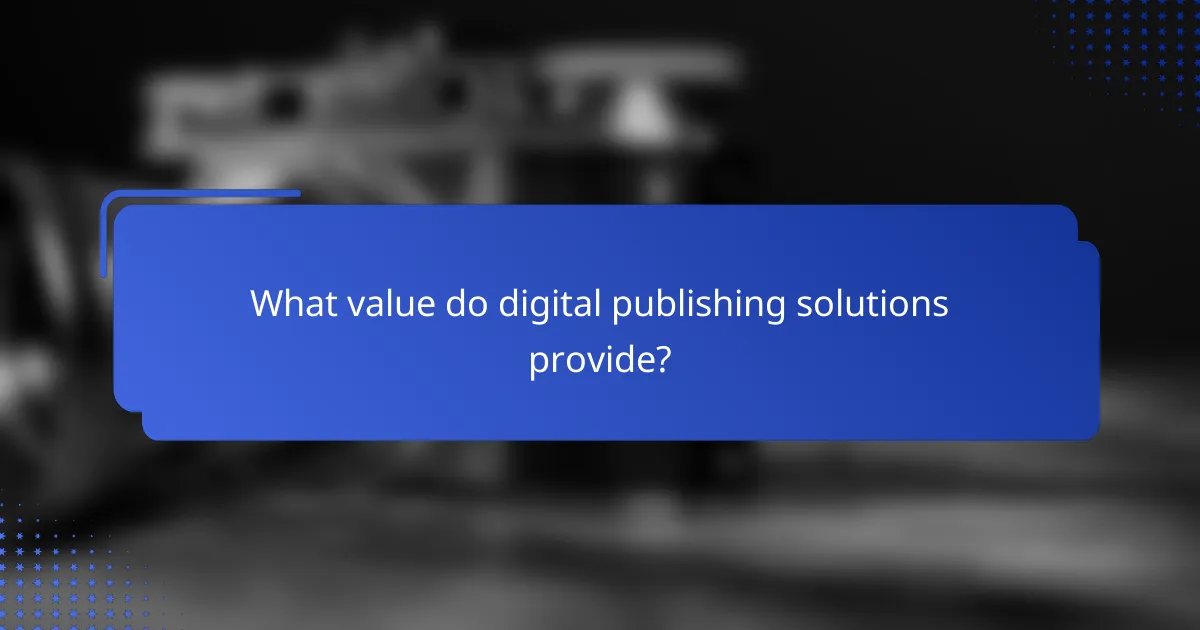
What value do digital publishing solutions provide?
Digital publishing solutions offer significant value by enhancing the distribution and accessibility of content while improving user engagement. They streamline the content management process, making it easier for creators to reach their audience effectively.
Increased reach and accessibility
Digital publishing solutions expand the reach of content by allowing it to be distributed across multiple platforms and devices. This accessibility ensures that users can engage with content anytime and anywhere, whether on a smartphone, tablet, or desktop.
Consider utilizing responsive design and optimizing for search engines to maximize visibility. This approach can significantly increase audience engagement, as users are more likely to interact with content that is easily accessible on their preferred devices.
Enhanced engagement metrics
With digital publishing, organizations can track user interactions through various metrics such as click-through rates, time spent on pages, and social shares. These insights help publishers understand audience preferences and tailor content accordingly.
Implementing interactive elements like quizzes, polls, or multimedia can further boost engagement. Regularly analyzing these metrics allows for continuous improvement in content strategy, ensuring that it resonates with the target audience.
Improved content management
Digital publishing solutions streamline content management by providing centralized platforms for creating, editing, and distributing materials. This efficiency reduces the time and resources needed to manage content across various channels.
Utilizing a content management system (CMS) can simplify workflows and enhance collaboration among teams. Establishing clear guidelines and processes for content creation and approval can help avoid common pitfalls, such as inconsistent messaging or delays in publication.
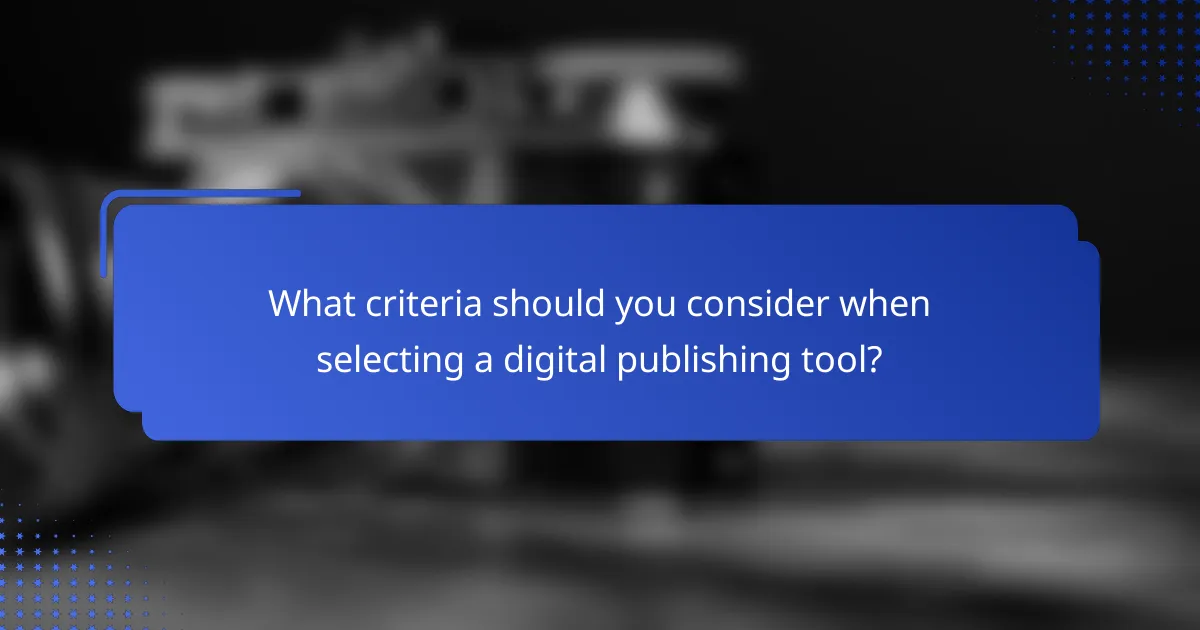
What criteria should you consider when selecting a digital publishing tool?
When selecting a digital publishing tool, consider factors such as integration capabilities, user support, and overall value for your specific needs. These criteria will help ensure that the tool enhances your publishing process and meets your operational requirements.
Integration capabilities
Integration capabilities refer to how well a digital publishing tool connects with other software and platforms you already use. Look for tools that easily integrate with content management systems (CMS), social media platforms, and analytics tools to streamline your workflow.
Consider tools that offer APIs or plugins for popular applications. This can save time and reduce manual data entry, allowing for a more efficient publishing process. A good integration can also enhance collaboration across teams and departments.
User support and resources
User support and resources are crucial for maximizing the effectiveness of your digital publishing tool. Evaluate the availability of customer support, including live chat, email, and phone options. Comprehensive documentation, tutorials, and community forums can also be valuable for troubleshooting and learning.
Choose a tool that provides ongoing training and updates to keep you informed about new features and best practices. This support can significantly impact your team’s ability to utilize the tool effectively and adapt to any changes in your publishing strategy.
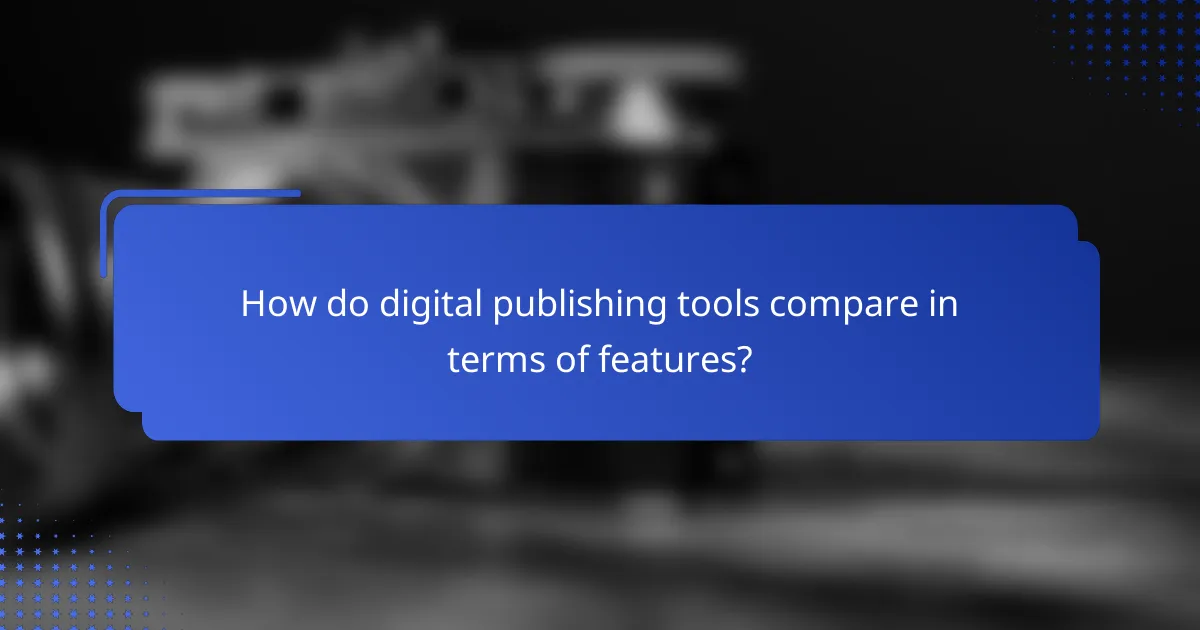
How do digital publishing tools compare in terms of features?
Digital publishing tools vary significantly in features, impacting user experience and overall value. Key aspects to consider include content creation capabilities, analytics, and reporting tools, which can enhance the effectiveness of digital publications.
Content creation features
Content creation features are essential for producing engaging digital publications. Most tools offer a range of templates, drag-and-drop interfaces, and multimedia integration options, allowing users to create visually appealing content without extensive technical skills. Popular platforms may include features like collaborative editing and version control, which streamline the content development process.
When evaluating content creation tools, consider the ease of use and the flexibility of design options. Some platforms may excel in specific areas, such as eBooks or interactive content, while others may provide a more general approach. Look for tools that align with your specific publishing goals and audience needs.
Analytics and reporting tools
Analytics and reporting tools are crucial for understanding audience engagement and measuring the success of digital publications. These features typically include metrics such as page views, time spent on pages, and user demographics, helping publishers refine their strategies. Many platforms offer real-time data, allowing for quick adjustments to content and marketing efforts.
When selecting a digital publishing tool, prioritize those that provide comprehensive analytics dashboards. This will enable you to track performance over time and identify trends. Additionally, consider tools that integrate with other marketing platforms for a more holistic view of your audience’s behavior and preferences.
